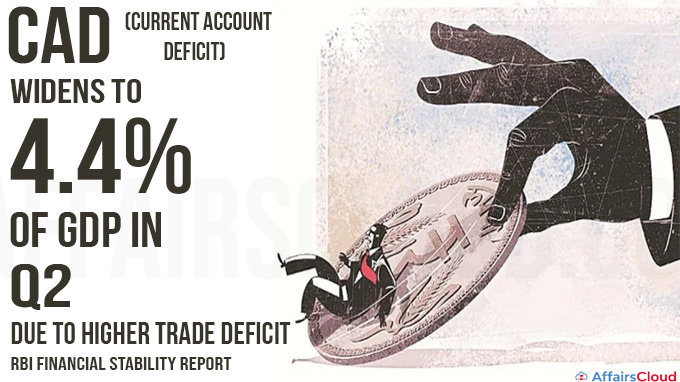
According to the Reserve Bank of India (RBI)’s 26th issue of of the Financial Stability Report (FSR) on December 29 2022 ,India’s Current Account Deficit (CAD) widened to 4.4 per cent of GDP in Q2:2022-23 from 2.2 per cent of GDP in the previous Q2:2022-23 and 1.2 per cent in 2021-22.
- In absolute terms, CAD was USD($)36.40 billion in Q2FY23 which is highest in more than a decade.
- As a percentage of GDP, it was 4.4%, the highest since the June quarter of 2013.
- India’s CAD is up from USD 18.2 billion (2.2% of GDP) in Q1FY23 and a deficit of US$ 9.7 billion (1.3% of GDP) in Q2FY22.
Key Points:
i.Services exports reported growth of 30.2% on a year-on-year (y-o-y) basis, driven by exports of software, business and travel services, while net services receipts increased sequentially and y-o-y.
ii.Private transfer receipts, mainly representing remittances by Indians employed overseas, rose by 29.7% to $27.4 billion from 2021.
India’s Balance of Payments (BoP) in Q2FY23
In accordance with the Reserve Bank of India (RBI) preliminary data on India’s Balance of Payments (BoP) for the July-September (Q2) quarter of FY 2022-23, India’s Current Account Deficit (CAD) widened in the Q2FY23 due to increased trade gap driven by high commodity prices and a weak rupee.
i.India’s foreign exchange reserves on BoP basis recorded a deficit of $30.4 billion compared to a $31.2 billion surplus in the Q2FY22.
ii.In the financial account, net Foreign Direct Investment (FDI) decreased to US$ 6.4 billion from US$ 8.7 billion in Q2FY22.
iii.Net Foreign Portfolio Investment recorded inflows of US$ 6.5 billion, up from US$ 3.9 billion during Q2FY22.
iv.Net external commercial borrowings to India recorded an outflow of US$ 0.4 billion in Q2FY23 as against an inflow of US$ 4.3 billion in Q2FY22.
v.Non-resident deposits recorded net inflows of US$ 2.5 billion as against net outflows of US$ 0.8 billion in Q2FY22.
vi.There was a depletion of foreign exchange reserves (on a BoP basis) to the tune of US$ 30.4 billion in Q2FY23 as against an accretion of US$ 31.2 billion in Q2FY22.
BoP during April-September 2022 (H1FY23)
i.India recorded a CAD of 3.3% of GDP in H1FY23 on the back of a sharp increase in the merchandise trade deficit, as compared with 0.2% in H1FY22.
ii.Net FDI inflows were at US$ 20.0 billion in H1FY23 as compared to US$ 20.3 billion in H1FY22.
iii.Portfolio investment recorded a net outflow of US$ 8.1 billion in H1FY23 as against an inflow of US$ 4.3 billion in H1FY22.
Banks’ net NPA ratio at 10-yr low
The RBI also released the 26th Financial Stability Report (FSR) which states the collective assessment of the Sub-Committee of the Financial Stability and Development Council (FSDC) on risks to financial stability and the resilience of the financial system. It is published bi-annually.
Key Points:
i.The Gross Non-Performing Asset (GNPA) ratio of scheduled commercial banks (SCBs) fell to a seven-year low of 5% and Net Non-Performing Assets (NNPA) have dropped to ten-year low of 1.3% in September 2022.
ii.The system-level capital to risk weighted assets ratio (CRAR) in September 2023, under baseline, medium and severe stress scenarios, is projected at 14.9%, 14% and 13.1%, respectively.
Banks using quality liquid assets to fund loan growth
As per the report, the banks are using their High-Quality Liquid Assets (HQLAs) to fund the demand for credit in the economy. The reason behind this is the slow deposit accretion and tight liquidity conditions.
Key points:
i.The Liquidity Coverage Ratio (LCR) has decreased from a high of 173% as of September 2020 to 135.6% as of September 2022. However, it still remains comfortably above the minimum regulatory requirement of 100%.
- LCR refers to the proportion of HQLAs held by banks, to ensure their ability to meet short-term obligations.
ii.The LCR of private banks have fallen more than Public Sector Banks (PSBs) and foreign banks.
- Private banks saw LCR drop to 121.8% as of September 2022 while PSBs dropped to 141.2%.
- On the other hand, foreign banks have relatively high LCR at 157.1% as of September 2022.
iii.HQLA is essentially cash or assets that can be converted into cash quickly through sales (or by being pledged as collateral) with no significant loss of value.
iv.Bank credit has grown at 17.4% YoY as on December 16, 2022 . Deposits growth moderated to 9.4% during the same period.
India’s persistent core inflation may exert upward pressure on CPI
The report also stated that India’s consumer price index (CPI) inflation has moderated.
- India’s headline retail inflation dropped to a 11-month low of 5.88% in November 2022 from 6.77% in October 2022.
Key Points:
i.As per the RBI’s estimates, annual inflation is seen cooling to 5.9% in January-March 2023 and 5% in April-June 2023 but is set to rise to 5.4% in the subsequent three months.
ii.Gross NPA ratio of all banks may improve from 5% in September 2022 to 4.9% by September 2023 under the baseline scenario.
Recent Related News:
i.According to the “State of the Economy” article featured on the monthly Bulletin of Reserve Bank of India – RBI Bulletin – November 2022, India’s real Gross Domestic Product GDP growth in 2nd quarter of 2022-2023 (Q2FY23) is expected to be between 6.1% and 6.3%.
ii.The International Financial Services Centres Authority (IFSCA) and the Reserve Bank of India (RBI) have signed a Memorandum of Understanding (MoU) to collaborate on regulation and supervision of regulated entities in their respective jurisdictions.
About Reserve Bank of India (RBI):
Governor– Shaktikanta Das
Deputy Governors– Mahesh Kumar Jain, Michael Debabrata Patra, M. Rajeshwar Rao, T. Rabi Sankar
Headquarters– Mumbai, Maharashtra
Establishment– 1st April 1935




